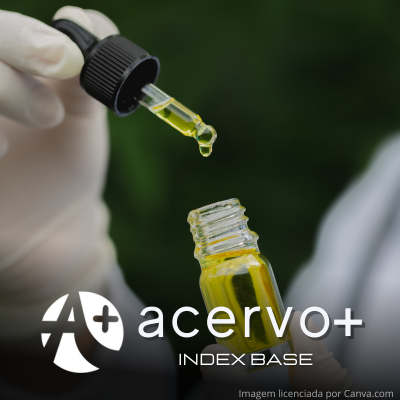O efeito terapêutico do extrato oleoso de Cannabis sp. na doença de Alzheimer induzida por cloreto de alumínio em ratos
##plugins.themes.bootstrap3.article.main##
Resumo
Objetivo: Avaliar o potencial terapêutico do extrato de Cannabis sp em modelo de Doença de Alzheimer induzida por cloreto de alumínio em ratos. Métodos: Trinta ratos Wistar foram divididos em cinco grupos (n=6) onde um dos grupos não recebeu nenhum tratamento, outro grupo recebeu apenas cloreto de alumínio e os demais, além do cloreto de alumínio, receberam diferentes doses (50, 100 e 150µl) de extrato oleoso de Cannabis sp. Os animais foram submetidos à eutanásia um dia após o tratamento, onde o cérebro foi coletado, fixado, processado e incluído em parafina. Cortes histológicos do hipocampo foram utilizados para avaliação qualitativa e quantitativa das alterações morfológicas. Soro sanguíneo também foi obtido para determinar indicadores do estado oxidativo. Resultados: Redução de mais de 80% da morte celular na região do giro denteado do hipocampo dos animais tratados com o extrato de cannabis. Além disso, também foi observada no soro uma redução nos níveis de proteínas totais em aproximadamente 20% e um aumento (15%) nas enzimas antioxidantes em relação ao controle positivo. Conclusão: O uso do extrato oleoso de Cannabis sp. em uma proporção de 2:1 de delta-9-tetrahidrocanabinol (THC): Canabidiol (CBD) reduziu efetivamente as mortes de neurônios do hipocampo por amiloidose induzida na intoxicação crônica por cloreto de alumínio.
##plugins.themes.bootstrap3.article.details##
Copyright © | Todos os direitos reservados.
A revista detém os direitos autorais exclusivos de publicação deste artigo nos termos da lei 9610/98.
Reprodução parcial
É livre o uso de partes do texto, figuras e questionário do artigo, sendo obrigatória a citação dos autores e revista.
Reprodução total
É expressamente proibida, devendo ser autorizada pela revista.
Referências
2. AKBAR M, et al. Mitochondrial dysfunction and cell death in neurodegenerative diseases through nitroxidative stress. Brain Research, 2016; 1637: 34–55.
3. AL-OKBI SY, et al. Evaluation of plant food extracts in experimental model of Alzheimer’s like disease induced by aluminum lactate in rats. Journal of Applied Pharmaceutical Science, 2017; 7: 070–076.
4. AUTI ST and KULKARNI YA. Neuroprotective effect of cardamom oil against aluminum induced neurotoxicity in rats. Frontiers in Neurology, 2019; 10: 1–17.
5. BLAISE GA, et al. Nitric oxide, cell signaling and cell death. Toxicology, 2005; 208: 177–192.
6. CAO C, et al. The potential therapeutic effects of THC on Alzheimer’s disease. Journal of Alzheimer’s Disease, 2014; 42: 973–984.
7. CASAREJOS MJ, et a. Natural cannabinoids improve dopamine neurotransmission and tau and amyloid pathology in a mouse model of tauopathy. Journal of Alzheimer’s Disease, 2013; 35: 525–539.
8. COSTA B, et al. The non-psychoactive cannabis constituent cannabidiol is an orally effective therapeutic agent in rat chronic inflammatory and neuropathic pain. European Journal of Pharmacology, 2007; 556: 75–83.
9. DRYBURGH LM, et al. Cannabis contaminants: sources, distribution, human toxicity and pharmacologic effects. British Journal of Clinical Pharmacology, 2018; 84: 2468–2476.
10. ENGLUND A, et al. Cannabidiol inhibits THC-elicited paranoid symptoms and hippocampal-dependent memory impairment. Journal of Psychopharmacology, 2013; 27: 19–27.
11. ESPOSITO G, et al. Cannabidiol inhibits inducible nitric oxide synthase protein expression and nitric oxide production in β-amyloid stimulated PC12 neurons through p38 MAP kinase and NF-κB involvement. Neuroscience Letters, 2006; 399: 91–95.
12. GHUMATKAR PJ, et al. Nootropic, neuroprotective and neurotrophic effects of phloretin in scopolamine induced amnesia in mice. Pharmacology Biochemistry and Behavior, 2015; 135: 182–191.
13. HANUŠ LO and HOD Y. Terpenes/Terpenoids in Cannabis: Are They Important? Medical Cannabis and Cannabinoids, 2020; 3: 61–73.
14. Hao F, Feng Y. Cannabidiol (CBD) enhanced the hippocampal immune response and autophagy of APP/PS1 Alzheimer’s mice uncovered by RNA-seq. Life Sciences, 2021; 264.
15. IUVONE T, et al. Neuroprotective effect of cannabidiol, a non-psychoactive component from Cannabis sativa, on β-amyloid-induced toxicity in PC12 cells. Journal of Neurochemistry, 2004; 89: 134–141.
16. KOPUSTINSKIENE DM, et al. Bioactive Compounds and Their Protective Role in Oxidative Stress and Inflammation. Antioxidants, 2022; 11: 660.
17. LAKSHMI BVS, et al. Protective Effect of Selenium Against Aluminum Chloride-Induced Alzheimer’s Disease: Behavioral and Biochemical Alterations in Rats. Biological Trace Element Research, 2015; 165: 67–74.
18. LOERA-VALENCIA R, et al. Current and emerging avenues for Alzheimer’s disease drug targets. Journal of Internal Medicine, 2019; 286: 398–437.
19. LOWRY OH, et al. Protein measurement with the folin phenol reagent. Analytical Biochemistry, 1951;193: 265–275.
20. MARKESBERY WR. Oxidative stress hypothesis in Alzheimer’s disease. Free Radical Biology and medicine, 1997; 23: 134–147.
21. MARTÍN-MORENO AM, et al. Prolonged oral cannabinoid administration prevents neuroinflammation, lowers β-amyloid levels and improves cognitive performance in Tg APP 2576 mice. Journal of Neuroinflammation, 2012; 9: 8.
22. MC V, et al. Immunochemical and morphometric features of astrocyte reactivity vs. plaque location in Alzheimer’s disease. Medicina (B Aires), 2005; 213–218.
23. OBERHOLZER M, et al. Methods in quantitative image analysis. Histochemistry and cell biology, 1996; 105: 333–355.
24. OHYAGI Y, MIYOSHI K. Aluminum and Alzheimer’s Disease: An Update. Alzheimer’s Disease & Parkinsonism, 2013; 3: 01–07.
25. OZCANKAYA R, Delibas N. Malondialdehyde, superoxide dismutase, melatonin, iron, copper, and zinc blood concentrations in patients with Alzheimer disease: Cross-sectional study. Croatian Medical Journal, 2002; 43: 28–32.

